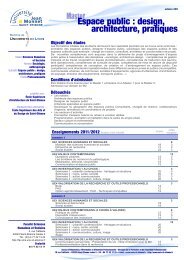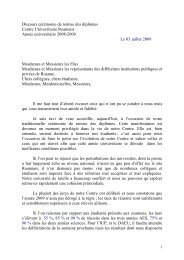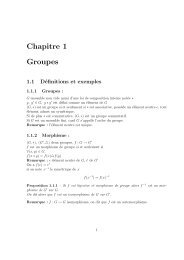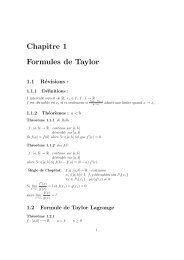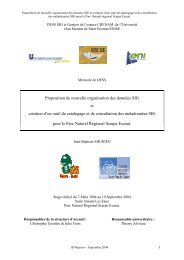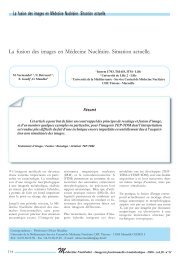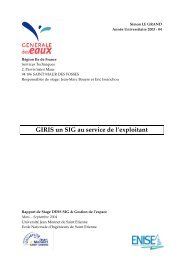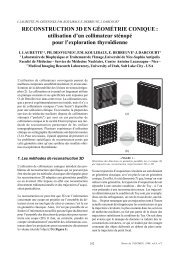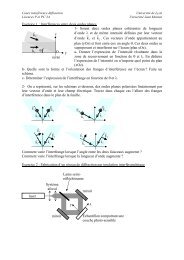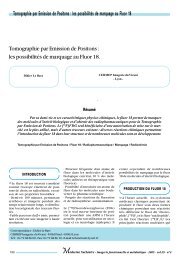Radiothérapie métabolique : état et perspectives.
Radiothérapie métabolique : état et perspectives.
Radiothérapie métabolique : état et perspectives.
You also want an ePaper? Increase the reach of your titles
YUMPU automatically turns print PDFs into web optimized ePapers that Google loves.
J.P. VuillezRadiothérapie métabolique : état <strong>et</strong> <strong>perspectives</strong>.Jean-Philippe VuillezService de Biophysique <strong>et</strong> Médecine NucléaireHôpital Michallon - CHU de Grenoble - GrenobleRésuméLa radiothérapie dite métabolique, ou mieux la radiothérapie interne vectorisée, consisteà irradier des cibles tumorales de p<strong>et</strong>ite taille <strong>et</strong> disséminées dans l’organisme au moyen demédicaments radioactifs. Elle s’impose de plus en plus comme une modalité thérapeutique nouvelleen cancérologie, forte d’arguments théoriques, expérimentaux mais également de résultatscliniques tangibles, ayant conduit à la mise sur le marché de plusieurs spécialités. Ses mécanismesd’action <strong>et</strong> les relations activité injectée/eff<strong>et</strong> sont encore largement à explorer, tant pourmaîtriser la dosimétrie que pour comprendre les phénomènes radiobiologiques en jeu. Il fautsouligner le rôle crucial de la biodistribution aux différents niveaux macroscopique, tissulaire <strong>et</strong>cellulaire, qui implique de considérables besoins de développement de l’imagerie scintigraphiquequantitative. Les résultats cliniques actuels, qui concernent avant tout les anticorps <strong>et</strong> les analoguesde la somatostatine, mais aussi les agents à visée osseuse, sont passés en revue ainsi que lesprincipales <strong>perspectives</strong> à court <strong>et</strong> moyen terme.Radiothérapie interne / Radiothérapie vectorisée / Ciblage / Radioanticorps / Métastases osseuses /Radioimmunothérapie / Analogues de la somatostatineINTRODUCTION!La radiothérapie dite métaboliqueconsiste à irradier des cibles tumoralesde p<strong>et</strong>ite taille <strong>et</strong> disséminées dansl’organisme au moyen de médicamentsradioactifs (radiopharmaceutiques)injectés par voie intraveineuse<strong>et</strong> marqués par des radionucléidesém<strong>et</strong>teurs de rayonnement β - , <strong>et</strong> dontles propriétés biologiques conduisentà un ciblage sélectif des cellulestumorales. Si sa première application,à savoir le traitement des cancers différenciésde la thyroïde, exploite lemétabolisme de l’iode pour accumulerde l’iode 131 dans les cellules tumorales,les divers radiopharmaceutiquesmaintenant utilisés dans ce domaineont une biodistribution quin’est pas toujours sous-tendue par unprocessus métabolique. Aussi l<strong>et</strong>erme de radiothérapie interne doitlui être préféré, ou mieux encore celuide radiothérapie interne vectorisée,pour rappeler la nécessité d’unemolécule vectrice <strong>et</strong> éviter la confusionavec certaines techniques de cu-Correspondance : Jean-Philippe VUILLEZService de Biophysique <strong>et</strong> Médecine Nucléaire - Hôpital Michallon -CHU de Grenoble - BP217 - 38043 Grenoble cedex 9Tel : Bureau 04 76 76 88 09 - Secrétariat : 04 76 76 54 55 - Fax 04 76 76 51 38 - E-mail : JPVuillez@chu-grenoble.frMédecine Nucléaire - Imagerie fonctionnelle <strong>et</strong> métabolique - 2005 - vol.29 - n°4 247
Radiothérapie métabolique : état <strong>et</strong> <strong>perspectives</strong>ri<strong>et</strong>hérapie interstitielle qui laissentles sources en place (cas de l’utilisationde grains d’iode 125 dans lescancers de la prostate).La principale limite de c<strong>et</strong>te méthod<strong>et</strong>hérapeutique est le rapport de l’activitétumorale à l’activité cumulée destissus sains : le niveau de l’activitéinjectée est, en eff<strong>et</strong>, limité par la toxicitéaux tissus normaux, en particulierla moelle osseuse, <strong>et</strong> si ce rapportest trop bas l’irradiation des cellulestumorales peut s’avérer insuffisante.LE RATIONNEL DELA RADIOTHÉRAPIE INTERNEVECTORISÉE!Si l’on se réfère à l’histoire naturelledes cancers <strong>et</strong> aux problèmes actuelsde leur prise en charge, il apparaît facilementque la radiothérapie interneest une réponse innovante à des situationsdans lesquelles l’approch<strong>et</strong>hérapeutique atteint ses limites.Que ce soit au diagnostic ou surtoutaprès traitement, l’un des problèmesmajeurs est celui de lésions nondécelables, au site initial ou à distance,source de récidives ultérieures<strong>et</strong> d’évolution métastatique. Ces lésionsoccultes, qui prennent aprèstraitement la dénomination de maladierésiduelle, ne peuvent pas pardéfinition être diagnostiquées, maisla probabilité de leur existence peutêtre approchée par l’analyse de facteurspronostiques <strong>et</strong> de facteurs derisque. Ceci justifie les traitementsnéoadjuvants <strong>et</strong> adjuvants mis enœuvre dans bon nombre de cas. Si lecontrôle local (éradication de cellulespouvant rester en place dans lechamp opératoire) <strong>et</strong> loco-régional(atteinte ganglionnaire éventuelle)peut être assuré par une irradiationexterne avec des techniques de radiothérapiede plus en plus performantes,d’hypothétiques localisationsdisséminées relèvent nécessairementd’un traitement systémique, en pratiqueune chimiothérapie avec les limitationsqu’entraînent les eff<strong>et</strong>s secondaires.En cas de reliquats tumoraux patentsou de dissémination métastatiqueavérée, les mêmes traitements s’imposent,mais on est alors en phaseévolutive <strong>et</strong> non plus en situationadjuvante, <strong>et</strong> le pronostic est en règlepéjoratif.Dans ces deux types de situation, lalimitation des traitements systémiquesdu fait de leur toxicité, a depuislongtemps fait émerger le concept deciblage, c’est-à-dire la possibilité d<strong>et</strong>raiter plus sélectivement les cellulestumorales, en limitant l’eff<strong>et</strong> sur lestissus sains, grâce à un agent vecteurapproprié. On peut ainsi vectoriserdiverses drogues ou agents pharmacologiques<strong>et</strong> augmenter leur indexthérapeutique. Dans ce contexte, l’utilisationde radiopharmaceutiques, quirevient à vectoriser des agents radioactifsém<strong>et</strong>teurs de particules chargées,se justifie avant tout par l’avantagemajeur qu’il n’est pas nécessairede cibler 100 % des cellules. Les cellulesnon ciblées peuvent en eff<strong>et</strong> êtreirradiées par les molécules marquéesfixées sur des cellules voisines (phénomènede « feu croisé »). Un autreavantage, moins bien défini, est lemode d’action original, sans aucunrapport avec celui des drogues, del’irradiation in situ par des électronsou des particules alpha. Tout en ayantla même vocation systémique que lachimiothérapie ou les biothérapies,la radiothérapie vectorisée agit de façondifférente, selon des mécanismesencore incomplètement connus. Lameilleurs utilisation de ce traitementpasse par une meilleurs compréhensiondes doses d’irradiation <strong>et</strong> deseff<strong>et</strong>s radiobiologiques qui en découlent.LES ASPECTS DOSIMÉTRIQUESET RADIOBIOLOGIQUESSur le plan dosimétrique, il faut insistersur plusieurs aspects essentiels,qui rendent l’approche radicalementdifférente du raisonnement qu’on aen radiothérapie externe. La radiothérapieinterne se singularise par la délivranced’une irradiation continueprolongée à bas débit de dose (quiplus est décroissant au cours dutemps en fonction de la période effectivequi combine la période physique<strong>et</strong> la période biologique). Deplus, <strong>et</strong> contrairement à la radiothérapieexterne (où l’on considère quele dépôt d’énergie à l’intérieur d’unecourbe d’isodose est isotrope <strong>et</strong> homogène),la source d’irradiation représentéepar la molécule radioactivese caractérise par une double hétérogénéité: hétérogénéité tissulaire toutd’abord, du fait de la biodistributionde la molécule qui, tributaire de lavascularisation <strong>et</strong> des perturbationsdu milieu interstitiel, conduit à uneconcentration tissulaire très variabled’un point à un autre ; hétérogénéitédu dépôt d’énergie à l’échelle cellulaireensuite, du fait du caractère aléatoirede la trajectoire des particulesdans la matière. Il résulte de tout cecique l’utilisation du gray (Gy), c’est-àdiredu joule par kilo, n’a pas grandsens en radiothérapie interne avecdes radiopharmaceutiques – <strong>et</strong> au minimumque la référence aux dosesdélivrées en radiothérapie externen’est pas licite, ou du moins doit êtreextrêmement circonspecte. Un Gy délivrépar une molécule radiomarquéein situ n’équivaut pas à un Gy délivrépar un faisceau externe, pour lesraisons que nous venons d’évoquer<strong>et</strong> aussi parce que les eff<strong>et</strong>s radiobiologiquesne sont pas équivalents.Les travaux qui tentent de résoudrece problème en montrent bien lesdifficultés, mais proposent des solutions,qui passent par les problèmesbien connus en Médecine Nucléairede correction d’atténuation <strong>et</strong> de correctionde diffusion [1]. En eff<strong>et</strong>, la biodistributiondes anticorps radioactifsne peut être appréhendée, en pratiqueclinique, qu’à partir d’acquisitionsscintigraphiques, planaires ou si possibl<strong>et</strong>omographiques. La connaissanceprécise de c<strong>et</strong>te biodistributionest préalable indispensable aucalcul de la dose, qui pose alorsmoins de problèmes avec les modèlesmaintenant validés avec le formalismedu MIRD [2,3]. Quoi qu’il ensoit, la dosimétrie en radioimmunothérapie(RIT) passe par la connaissancede l’activité tumorale <strong>et</strong> de labiodistribution chez chaque patient<strong>et</strong> à ce titre ne peut être qu’individuelle[4,5]. Il n’existe pas de relationsimple entre l’activité injectée <strong>et</strong> la248 Médecine Nucléaire - Imagerie fonctionnelle <strong>et</strong> métabolique - 2005 - vol.29 - n°4
J.P. Vuillezdose délivrée aux tissus, en particulierà la tumeur.Sur le plan radiobiologique, la délivranced’une irradiation continueprolongée à bas débit de dose n’a pasles mêmes conséquences qu’une irradiationaiguë [6].En radiothérapie externe, l’irradiationest délivrée sous forme fractionnée,avec des doses intermittentes <strong>et</strong> desdébits de doses élevés (de l’ordre de60 Gy/h). La radiothérapie vectoriséeconstitue une modalité radicalementdifférente, <strong>et</strong> les conséquencesradiobiologiques ne sont pas comparables.Beaucoup d’études ont été faitesà propos des radioanticorps pourla radioimmunothérapie. L’irradiationest délivrée sous forme continue <strong>et</strong> àbas débit, celui-ci augmentant dans unpremier temps avec la fixation duradioanticorps dans la tumeur, puisdiminuant en fonction de la décroissanceradioactive <strong>et</strong> de l’éliminationbiologique. Ce débit de dose est del’ordre de 0,1 à 0,5 Gy/h [7,8]. L’efficacitéde faibles débits de dose (inférieursà 0,4 Gy/h) a été démontré invitro ; des débits supérieurs à 0,23 Gy/h sont nécessaires pour arrêter lacroissance de cellules épithélialesmalignes [9,10], alors que des débitsde 0,09 à 0,11 Gy/h peuvent suffirepour les cellules HeLa <strong>et</strong> les cellulesd’hépatome de Morris [11], <strong>et</strong> mêmedes débits aussi faibles que 0,05 Gy/h pour des cellules de lymphome[12]. Toutefois ces résultats anciensn’ont pas toujours été r<strong>et</strong>rouvés[13,14] <strong>et</strong> certains travaux font mêmeétat d’une radiorésistance induite parune exposition chronique à un débitde dose faible [15].En fait, à cause de ce bas débit dedose, qui perm<strong>et</strong> une plus grande efficacitédes mécanismes de réparationcellulaire, l’efficacité théorique d’unedose délivrée par RIT (avec les réservesprécédemment envisagées quantà c<strong>et</strong>te notion) est inférieure de 20 %environ à celle de la même dose délivréeen radiothérapie externe [16].C<strong>et</strong>te différence peut atteindre 300 %dans des modèles in vivo [17], maisil faut alors faire la part de la mauvaisedistribution du radioan-ticorpsdans la tumeur, qui préserve des zonestumorales <strong>et</strong> ne préjuge donc pasde l’inefficacité du bas débit de dosecontinu [18]. L’efficacité relative dela radiothérapie externe <strong>et</strong> de la RITdépend en outre de la radiosensibilité<strong>et</strong> des capacités de réparation [19].D’autre part, les anticorps par euxmêmespeuvent avoir un eff<strong>et</strong> sur latumeur (c’est notamment vrai dansles lymphomes), ce qui compliquel’interprétation de l’eff<strong>et</strong> radiobiologiqueproprement dit. La RIT isolémentn’est probablement pas, en dehorsde cas privilégiés, en mesured’être curatrice <strong>et</strong> son utilisation passerasans doute par l’association àd’autres modalités thérapeutiques[20].La prolifération cellulaire est un facteurde moindre efficacité de la RIT,puisqu’elle perm<strong>et</strong> à une certaine fractioncellulaire d’échapper à l’expositionau radioanticorps ; ceci estd’autant plus marqué que l’on utilisedes radio-isotopes de période longue[13,16]. Pour c<strong>et</strong>te raison, les tumeursd’évolution lente pourraient être plussensibles aux bas débits de dose [13]<strong>et</strong> donc constituer une bonne ciblede la RIT.D’une façon qui paraît contradictoireavec les données précédentes, certainstravaux avec des tumeurs humainesgreffées chez la souris nude fontétat d’une efficacité supérieure, danscertaines circonstances, avec la RITqu’avec la même dose estimée en Gyen radiothérapie externe [21-23].Parmi les arguments avancés (réoxygénation,ciblage préférentiel des cellulesen cycle, blocage en phase G2[22-24] ), la plus séduisante est celled’une apoptose radio-induite par lebas débit de dose continu ; c<strong>et</strong>te hypothèseest en eff<strong>et</strong> confortée parplusieurs travaux [25-28]. C<strong>et</strong> eff<strong>et</strong> estdu reste étroitement relié aux capacitésde réparation cellulaire [28],dont dépend la radiosensibilité, desorte qu’aux bas débits de dose, ilsemble exister un équilibre précaireentre mort cellulaire par nécrose,apoptose <strong>et</strong> réparation des lésionssublétales, ce qui explique des variationsimportantes de la réponse pourde faibles variations du débit de doseen dessous de 1 Gy/h [16] ; le débitde dose serait ainsi le facteur le plusimportant pour l’efficacité de la RIT,<strong>et</strong> il existerait un débit de dose optimalpour obtenir la meilleure réponse[29].Des <strong>perspectives</strong> très séduisantess’ouvrent depuis quelques annéesavec les travaux récents démontrantque les bas débits de dose n’agissentpas seulement directement sur lescellules, mais aussi en induisant desphénomènes secondaires ; il faut enparticulier insister sur l’instabilitégénétique radio-induite <strong>et</strong> sur les eff<strong>et</strong>sde voisinage des cellules irradiéessur les cellules non directementirradiées ("bystander effect")[30]. Il y a encore beaucoup à comprendrepour mieux appréhender larelation dose-eff<strong>et</strong> <strong>et</strong> donc les possibilitésd’optimiser c<strong>et</strong>te approche.La plupart des études concernant laradiobiologie de la RIT envisagentl’utilisation d’ém<strong>et</strong>teurs β - , c’est à dired’électrons dont le transfert d’énergielinéique (TEL) est faible ; ceci signifieque la densité des ionisationsresponsables des lésions cellulairesest faible sur le parcours des particules.Compte tenu du fait qu'environ200 lésions double brin de l’ADN parcellule sont nécessaires pour stériliser99% d’une population de cellulestumorales [31], <strong>et</strong> des capacitésde réparation des lésions sublétales,on conçoit que l’efficacité de la RITsoit limitée <strong>et</strong> très dépendante del’hétérogénéité de distribution duradioanticorps dans la tumeur. C’estpourquoi on s’oriente vers l’utilisationd’ém<strong>et</strong>teurs β - plus énergétiques(par exemple l’yttrium 90 [32,33] oule rhénium 188 [34] plutôt que l’iode131), <strong>et</strong> vers l’utilisation d’ém<strong>et</strong>teursα [35-40], de TEL très élevé <strong>et</strong> quidélivrent sur leur parcours, court <strong>et</strong>rectiligne, une très forte densité d’ionisations.Les radioéléments à TEL élevésont en outre l’avantage d’avoirune efficacité biologique pratiquementindépendante de l’oxygénationdu tissu tumoral, puisque les lésionsde l’ADN sont essentiellement directes<strong>et</strong> passent très peu par la radiolysede l’eau <strong>et</strong> les radicaux peroxydes.Au total la comparaison avec la radiothérapieexterne a ses limites, dans laMédecine Nucléaire - Imagerie fonctionnelle <strong>et</strong> métabolique - 2005 - vol.29 - n°4 249
J.P. VuillezL’association à la chimiothérapie commenceà être explorée [81-84]. Il estclair que les deux modalités se potentialisent,au prix d’une toxicitéhématologique élevée, <strong>et</strong> bien que lesmodalités d’association doivent êtreoptimisées, c’est là très certainementune voie d’avenir.Dans les tumeurs solides, les résultatssont beaucoup plus préliminaires,en raison essentiellement d’unebiodistribution beaucoup moins favorable.Cependant, des études sontpubliées, qui laissent penser que c<strong>et</strong>tevoie thérapeutique vaut la peined’être explorée. La faible fixation tumoraleexplique que certains auteursaient recours à des injections intratumorales(ce qui enlève beaucoupde son intérêt à la technique) [85], <strong>et</strong>que la plupart des études n’aient pasdonné de résultats très significatifsaprès injection directe de l’anticorpsradiomarqué. Il faut toutefois soulignercertaines études encourageantesen particulier dans les cancers du rein[86,87].La meilleure solution pour améliorerle rapport activité dans la tumeur /activité dans les tissus demeure leciblage en deux temps "pre-targ<strong>et</strong>ing"qui utilise essentiellement le systèmeavidine-biotine [88], ou les anticorpsbispécifiques anti-antigène de tumeur/anti-haptène[89-93].Les analogues radiomarquésde la somatostatine (SMS)! Dans le cas des tumeurs endocrines,la propriété biologique exploitéeest la surexpression de récepteursà la somatostatine qui est une caractéristiquepratiquement constante deces tumeurs tant qu’elles restent différenciées.L’octréotide marqué à l’indium 111 aété utilisé à des activités élevées dufait de sa disponibilité <strong>et</strong> de son émissiond’électrons Auger qui peut êtreefficace dès lors que le complexe ligand-récepteurest internalisé, exposantainsi l’ADN au parcours des électrons[94-97]. Krenning <strong>et</strong> coll. [96]ont traité 30 patients à un stade avancéde tumeur endocrine, dont 20 de tumeursGEP ; 21 de ces patients, tousen progression, ont reçu une activitécumulée de 20 GBq. Six ont présentéune réponse tumorale liée à un eff<strong>et</strong>antiproliférant, <strong>et</strong> 8 ont eu une stabilisationde leur maladie. Dans uneautre série de 27 patients [98], traitéspar 2 injections de 111 In-pent<strong>et</strong>réotide,2 réponses partielles ont été obtenues,ainsi que des nécroses tumoralessignificatives chez 7 patients, sanseff<strong>et</strong> secondaire. La médiane de surviea été de 18 mois contre 6 attendus.Cependant, ces réponses sont decourte durée, soit du fait de la sélectionde clones résistants, soit du faitque les patients traités, en phase avancée,présentaient des masses tumoralesimportantes, dont on sait qu’ellesne sont pas la meilleure indicationde radiothérapie interne [99,100]. Ilest probable que l’efficacité pourraitdevenir significative pour le traitementde micrométastases, voire ensituation adjuvante [101].En France, une centaine de patientsont pu être traités avec l’octréotideindium111 dans la cadre d’ATU nominatives,avec des résultats similairesà ceux de la littérature [102].Soulignons le fait que la toxicité dece traitement est limitée, avec unedose cumulée maximale tolérable de100 GBq [101].Malgré ces quelques résultats positifs,l’indium 111 en raison de la faibleénergie de ses électrons, de la difficultéde mise en œuvre pour utiliserles activités très élevées requises(avec pour conséquence un coûtélevé), ne représente pas la solutionidéale <strong>et</strong> il est clair qu’on doit lui préférerles ém<strong>et</strong>teurs bêta. Ceux-ci ontun eff<strong>et</strong> thérapeutique supérieur dufait de leur énergie plus élevée[96,102,103].L’octréotide marqué à l’yttrium 90 aété le premier proposé. Il s’agit del’agent utilisé pour le diagnostic enscintigraphie, le Tyr 3 -octréotide, coupléà un agent chélatant, le DOTA,perm<strong>et</strong>tant son marquage à l’yttrium90, ém<strong>et</strong>teur bêta pur. On obtient ainsile 90 Y-DOTA-D-Phe 1 -Tyr 3 -octréotide( 90 Y-SMT487 ou Octréother, Novartis)[96,105,106].L’étude de Paganelli <strong>et</strong> coll [107] réaliséechez 39 patients avec une escaladede dose, a montré un taux deréponses objectives (réponses complètes<strong>et</strong> partielles) de 23 % <strong>et</strong> unestabilisation de la maladie dans 64 %des cas. Les résultats des études dephase II sponsorisées par Novartissont en cours d’analyse <strong>et</strong> de publication.Ils viennent compléter les résultatspréliminaires déjà connus quiont montré l’intérêt potentiel de cecomposé [104,105; 108-109].Le principal obstacle à l’utilisation del’octréother a été sa néphrotoxicitéimportante, mais qui a pu être considérablementréduite grâce à la perfusiond’acides aminés immédiatementavant celle du produit [104, 105,108].Un composé très voisin del’octréother, le 90 Y-DOTATOC, a égalementété étudié. Dans un premiergroupe de 10 patients porteurs d<strong>et</strong>umeurs endocrines métastatiques, unralentissement de la croissance tumorale<strong>et</strong> une diminution des sécrétionshormonales <strong>et</strong> des symptômes ontété obtenus chez 6 patients, sans eff<strong>et</strong>ssecondaires, tandis que les autresétaient stabilisés [104,110,111]. Dansun autre groupe de 29 patients, sixont été mis en rémission, <strong>et</strong> 20 ontété stabilisés [111]. Dans un essai dephase II plus récent (non randomisé)ayant inclus 37 patients avec des tumeursGEP évolutives, un taux deréponse objective de 24 % a ététrouvé (<strong>et</strong> 36 % pour les tumeurspancréatiques), ceci sans toxiciténotable ; il était même suggéré uneff<strong>et</strong> bénéfique sur la survie [112].Le lanréotide est un analogue de laSMS qui présente une affinité un peudifférente de celle de l’octréotidepour les récepteurs de la SMS [113].Chez un premier patient porteur d’ungastrinome métastatique, traité par 4injections de 1 GBq de 90 Y-lanréotide,ce produit a permis une régressionde 25 % des métastases hépatiques <strong>et</strong>une amélioration significative dessymptômes [114]. Un essai de phaseIIa multicentrique a ensuite été misen place (MAURITIUS pourMulticenter Analysis of a UniversalReceptor Imaging and Treatment Initiative)[113]. Trente neuf patientsporteurs de tumeur GEP (dont 34 tu-Médecine Nucléaire - Imagerie fonctionnelle <strong>et</strong> métabolique - 2005 - vol.29 - n°4 251
Radiothérapie métabolique : état <strong>et</strong> <strong>perspectives</strong>meurs carcinoïdes) ont reçu par voieveineuse des activités de 1 GBq de90Y-DOTA-lanréotide en 30 minutessans protection rénale. Après deuxinjections, le traitement était arrêté encas de progression, sinon deux injectionssupplémentaires étaient réalisées.Durant un suivi de 3 ans, unerégression a été observée chez 20,5%des patients, <strong>et</strong> une stabilisation chez43,6 %. Ce produit n’est cependantplus en développement, car dansl’ensemble il est admis que sa fixationsur les lésions est inférieure àcelle de l’octréother qui lui est préféré.L’octréotate est un nouvel analoguede la SMS qui présente de loin l’affinitéla plus élevée pour les récepteursde type 2 par rapport à tous les autrescomposés [101]. Le [DOTA 0 ,Tyr 3 ]octréotate a une affinité pour le récepteurSS2 neuf fois supérieure àcelle du [DOTA 0 ,Tyr 3 ]octréotide[115]. Marqué au lutétium 177 ( 177 Lu),ce composé s’est montré très efficacesur des modèles tumoraux chez lerat, en perm<strong>et</strong>tant d’obtenir des régressionstumorales <strong>et</strong> en augmentantla survie des animaux [116]. Il a étémarqué avec divers autres ém<strong>et</strong>teursbêta ( 90 Y, 153 Sm, 186 Re) mais il sembleque les meilleurs rapports tumeur/tissus <strong>et</strong> surtout tumeur/rein soientobtenus avec le [ 177 Lu -DOTA 0 ,Tyr 3 ]octréotate [101]. De plus le 177 Lu a descaractéristiques physiques qui en fontun très bon agent de radiothérapie interne: énergie bêta moyenne de 0,13MeV (<strong>et</strong> maximale de 0,5 MeV) conférantun parcours moyen des électronsde 3 mm environ, période de6,71 jours, émission gamma de 208keV avec 11% d’intensité perm<strong>et</strong>tantun contrôle scintigraphique dans desconditions peu contraignantes de radioprotection.Dans une étude préliminaire chez 18patients [117], Kwekkeboom <strong>et</strong> collont montré que l’activité tissulaire enpourcentage de l’activité injectée,était similaire dans les reins, le foie<strong>et</strong> la rate pour le 177 Lu-octreotate <strong>et</strong>pour le 111 In-octreotide, mais qu’enrevanche l’activité tumorale était 4 à5 fois supérieure. Il semble donc quel’on puisse obtenir avec ce composéune meilleure irradiation des lésionsavec des doses supérieures aux tumeurs,sans augmentation de la toxicitépour les organes limitants. Dansc<strong>et</strong>te étude, une rémission partielle aété obtenue chez 39 % des patients.Ces mêmes auteurs ont récemmentpublié une étude d’escalade de dosechez 35 patients [118]. Les patientsont reçu des injections répétées séparéesde 6 à 9 semaines avec desactivités cumulées allant de 20 à 29,6GBq. Une toxicité hématologique degrade 3 a été observée dans 1% descas <strong>et</strong> aucune néphrotoxicité significativen’a été notée. Parmi 34 patientsévaluables avec un recul de 3 mois,un patient (3%) a présenté une rémissioncomplète, 12 (35%) ont présentéune réponse partielle, 14 (41%) ontété stabilisés <strong>et</strong> 7 (21%) ont progressé(dont 3 décès).Il apparaît donc que le [ 177 Lu -DOTA 0 ,Tyr 3 ]octréotate soit un agentparticulièrement intéressant pour laradiothérapie interne vectorisée destumeurs GEP. Cela justifie, en l’absencede traitement alternatif validé<strong>et</strong> le contexte souvent attentiste danslequel se trouvent les patients, desétudes multicentriques d’évaluationde l’efficacité sur de plus grandesséries de patients.CONCLUSIONSET PERSPECTIVES!Il ne fait plus de doute que la radiothérapievectorisée est à considérercomme une modalité de traitementdes cancers à part entière, appeléeà une utilisation croissante.Pour autant, sa place dans les différentespathologies est encore largementà définir. Quelques axes sur lesquelsdoivent porter les efforts peuventêtre proposés.Au delà de son succès dans les lymphomesmalins, le développement dela radiothérapie vectorisée dans lestumeurs solides implique une délimitationrationnelle de ses indications.Celles-ci concerneront des lésionsde p<strong>et</strong>ites tailles, disséminées,inaccessibles à un traitement chirurgical.On peut anticiper une utilisationen complément de gestes d’exérèse,voire à l’extrême en situationadjuvante <strong>et</strong> néoadjuvante.Dans c<strong>et</strong>te logique, il est tout aussiclair que la radiothérapie vectoriséedevra probablement être associée,simultanément ou en administrationséquentielle, avec des chimiothérapies<strong>et</strong> des immunothérapies.L’expérience clinique accumuléemontre des taux de réponse élevés,mais assortis de durées de réponsefaible <strong>et</strong> d’un impact encore limitésur la survie. L’avenir de la méthodepasse donc par la répétition des injections,posant la question de l’immunisation(résolue à terme par l’humanisationdes anticorps) <strong>et</strong> de latoxicité radio-induite (myélo-dysplasies).L’utilisation de cocktails d’anticorpsest également une perspectiv<strong>et</strong>rès étudiée.La maîtrise de c<strong>et</strong>te approche imposeracelle de la dosimétrie très particulière(bas débit de dose continu,prolongé <strong>et</strong> hétérogène) qui lui estliée, <strong>et</strong> une meilleure compréhensiondes mécanismes radiobiologiques enjeu. Ceci passe par le développementde l’imagerie quantitative, qui bénéficieen ce moment d’avancées significatives[119,120]Il faut d’autre part augmenter le rapportT/NT, ce qui, nous l’avons vu bénéficiede progrès dans la conceptiondes radiopharmaceutiques, avec parexemple le système en deux temps"AES". Dans le domaine des anticorps,un bon exemple de développementest illustré par les anticorps humanisésantiCD22 qui ont la propriétéd’internaliser après reconnaissancede l’antigène. Dans le domaine desligands de récepteurs, la mise aupoint de peptides d’affinité augmentéepour les récepteurs montre égalementque des progrès significatifssont possibles [121].Enfin l’utilisation d’ém<strong>et</strong>teurs alpha[35,122] au TEL élevé est une possibilitéqui prend de plus en plus deréalité.Nul doute par conséquent que les servicesde médecine nucléaire aurontà prendre dans les années à venir unepart de plus en plus active, avec lesconséquences sur leur fonctionnement<strong>et</strong> leurs relations avec les autresservices, dans le traitement des cancers.252 Médecine Nucléaire - Imagerie fonctionnelle <strong>et</strong> métabolique - 2005 - vol.29 - n°4
J.P. VuillezTarg<strong>et</strong>ed radiotherapy : state of the art and <strong>perspectives</strong>Internal targ<strong>et</strong>ed radiotherapy (previously called m<strong>et</strong>abolic radiotherapy) consists in anin situ irradiation of small tumour lesions all through the body by mean of a radiolabeled agent.It is a more and more emerging technique of cancer treatment, as clearly demonstrated bytheor<strong>et</strong>ical and experimental considerations, but also impressive clinical results. Published resultsallowed the mark<strong>et</strong>ing authorization of several specialities at time. Mechanisms of action andrelationships b<strong>et</strong>ween injected activity and efficacy are still under investigations in order to b<strong>et</strong>terunderstanding dosim<strong>et</strong>ric and radiobiological data. Of especially great matter is the knowledge ofradiopharmaceuticals biodistribution at macroscopic, tissues and cells levels. Thus there is a greatneed of quantitative imaging which deserves to be further investigated. Main clinical results, i.e.these obtained with radiolabels antibodies, somatostatin analogs and bone seeking agents arereviewed, and <strong>perspectives</strong> are quickly depicted.Internal radiotherapy / Targ<strong>et</strong>ed radiotherapy / Radiolabeled antibody / Bone m<strong>et</strong>astases / RadioimmunotherapySomatostatin analogsRÉFÉRENCES1. Siegel JA, Thomas SR, Stubbs JB, Stabin MG,Hays MT, Koral KF <strong>et</strong> al. MIRD pamphl<strong>et</strong> No.16 : techniques for quantitativeradiopharmaceutical biodistribution data acquisitionand analysis for use in human radiationdose estimates. J Nucl Med1999;40:37s-61s2. Leichner PK, Kwok CS. Tumor dosi-m<strong>et</strong>ry inradioimmunotherapy : m<strong>et</strong>hods of calculationfor b<strong>et</strong>a particles. Med Phys 1993;20:529-343. Erwin WD, Groch MW, Macey DJ, DeNardo GL,DeNardo SJ, Shen S. A radioimmunoimagingand MIRD dosim<strong>et</strong>ry treatment planningprogram for radioimmunotherapy. Nucl MedBiol 1996 ; 23 : 525-324. Juweid ME, Hajjar G, Stein R, Sharkey RM,Herskovic T, Swayne LC <strong>et</strong> al. Initial experiencewith high-dose radioimmunotherapy ofm<strong>et</strong>astatic medullary thyroid cancer using131I-MN-14F(ab) 2anti-carcinoembryonicantigen Mab and AHSCR. J Nucl Med 2000;41:93-1035. DeNardo SJ. Tumor-targ<strong>et</strong>ed radionuclid<strong>et</strong>herapy : trial design driven by patientdosim<strong>et</strong>ry. J Nucl Med 2000;41:104-66. Hernandez MC, Knox SJ. Radiobiology ofradioimmunotherapy : targ<strong>et</strong>ing CD20 B-cellantigen in non-hodgkin’s lymphoma. Int J RadiationOncology Biol Phys 2004 ; 59:1274-877. Langmuir VK, Mendonca HL, VanderheydenJL, Su FM. Compari-sons of the efficacy of 186 Reand131 I-labeled antibody in multicellspheroids. Int J Radiation Oncology Biol Phys1992;24:127-328. Mayer R, Dillehay LE, Shao Y, Zhang YG, SongS, Bartholomew RM <strong>et</strong> al. Direct measurementof intratumor dose-rate distributions in experimenttalxenografts treated with 90Y-labeledradioimmunotherapy. Int J RadiationOncology Biol Phys 1995;32:147-579. Mitchell JB, Bedford JS, Bailey SM : dose-rateeffects on the cell cycle and survival of S3HeLa and V79 cells. Radiation Res1979;79:520-3610. Mitchell JB, Bedford JS, Bailey SM : dose-rateeffects in mammalian cells in culture III.Comparison of cell killing and cell proliferationduring continuous irradiation for six differentcell lines. Radiation Res 1979;79:537-5111. Szechter A, Schwartz G, Barsa JM. Continuousand fractionated irradiation of mammaliancells in culture-I. The effect of growth rate . IntJ Radiat Oncol Biol Phys 1978;4:991-100012. Courtenay VD. Radioresistant mutants ofL5178Y cells. Radiat Res 1969;38:186-20313. Shipley WU, PeacockJH, Steel GG, Stephens TC.Continuous irradiation of the Lewis lungcarcinoma in vivo at clinically-used "ultra"low-dose-rates. Int J Radiat Oncol Biol Phys1983;9:1647-5314. McMillan TJ, Eady JJ, Peacock JH, Steel GG.Cellular recovery in two sub-lines of theL5178Y murine leukaemic lymphoblast cellline differing in their sensitivity to ionizingradiation. Int J Radiat Biol 1992;61:49-5615. Beer JZ, Mencl J, Horng MF, Gregg EC, EvansHH. Effects of low dose rate (0.003-0.025 Gy/h) chronic X-irradiation on radioresistant andradiosensitive L178Y mouse lymphoma cells.Int J Radiat Biol Relat Stud Phys Chem Med1985; 48:609-1916. Fowler JF Radiobiological aspects of low doserates in radioimmunotherapy. Int J RadiatOncol Biol Phys 1990;18:1261-917. Barendswaard EC, O’Donoghue JA, Larson SM,Tschmelitsch J, Welt S, Finn RD <strong>et</strong> al. 131 Iradioimmuno-therapy and fractionatedexternal beam radiotherapy : comparativeeffectiveness in a human tumor xenograft. JNucl Med 1999;40:1754-6818. Williams JA, Edwards JA, Dillehay LE. Quantitativecomparison of radiolabeled antibodytherapy and external beam radiotherapy inthe treatment of human glioma xenografts.Int J Radiation Oncology Biol Phys1998;24:111-719. Buras RR, Wong JYC, Kuhn JA, Beatty BG,Williams LE, Wanek PM <strong>et</strong> al. Comparison ofradioimmunotherapy and external beamradiotherapy in colon cancer xenografts. Int JRadiation Oncol Biol Phys 1993;25:473-920. Langmuir VK, Fowler JF, Knox SJ, Wessels BW,Sutherland RM, Wong JYC. Radiobiology ofradiolabeled antibody therapy as applied totumor dosim<strong>et</strong>ry. Med Phys 1993; 20:601-10Médecine Nucléaire - Imagerie fonctionnelle <strong>et</strong> métabolique - 2005 - vol.29 - n°4 253
Radiothérapie métabolique : état <strong>et</strong> <strong>perspectives</strong>21. Wessels BW, Vessela RL, Palme DF II, BerkopecJM, Smith GK, Bradley EW. Radiobiologicalcomparison of external beam irradiation andradioimmunotherapy in renal cell carcinomaxenografts. Int J Radiat Oncol Biol Phys1989;17:1257-6322. Knox SJ, Levy R, Miller RA, Uhland W, SchieleJ, Ruehl W <strong>et</strong> al. D<strong>et</strong>erminants of the antitumoreffect of radiolabed monoclonal antibodies.Cancer Res 1990;50:4935-4023. Knox SJ, Goris ML, Wessels BW. Overview of animalstudies comparing radioimmunotherapywith dose equivalent external beam irradiation.Radiother Oncol 1992 ; 23:111-724. Knox SJ, Sutherland W, Goris ML. Correlation oftumor sensitivity to low-dose-rate irradiationwith G2/M-phase block and other radiobiologicalparam<strong>et</strong>ers. Radiat Res 1993;135:24-3125. Story MD, Voehringer DW, Malone CG, HobbsML, Meyn RE. Radiation-induced apoptosis insensitive and resistant cells isolated from amouse lymphoma. Int J Radiat Biol 1994;66:659-6826. Dubray B, Br<strong>et</strong>on C, Klijanienko J,Maciorowski Z, Viehl P, Fourqu<strong>et</strong> A <strong>et</strong> al. Invitro radiation-induced apoptosis and earlyresponse to low-dose radiotherapy in non-Hodgkin’s lymphomas. Radiother Oncol 1998;46:185-9127. Belka C, Heinrich V, Marini P, Faltin H, Schulze-Osthoff K, Bamberg M <strong>et</strong> al. Ionizing radiationand the activation of caspase-8 in highlyapoptosis-sensitive lymphoma cells. Int J radiatBiol 1999;75:1257-6428. Szumiel I, Jaworska A, Kapiszewska M, JohnA, Gradzka I, Sochanowicz B. Differential inductionof apoptosis in x-irradiated L5178Ysulines bearing p53 mutation. Radiat EnvironBiophys 2000;39: 33-4029. Filippovich IV, Soronika N, Robillard N, Faivre-Chauv<strong>et</strong> A, Bardies M, Chatal JF. Cell deathinduced by a 131 I-labeled monoclonalantibody in ovarian cancer multicellspheroids. Nucl Med Biol 1996;23:323-2630. Bourguignon MH, Gisone PA, Oerez MR, MichelinS, Dubner D, Di Giorgio M, CarosellaED. Gen<strong>et</strong>ic and epigen<strong>et</strong>ic features in radiationsensitivity. Eur J Nucl Med Mol Imaging2005;32:229-4631. Cobb LM, Humm JL. Radioimmuno-therapyof malignancy using antibody targ<strong>et</strong>ed radionuclides.Br J Cancer 1986;54:863-7032. Foss FM, Raubitscheck A, Mulshine JL, FleisherTA, Reynolds JC, Paik CH <strong>et</strong> al. Phase I studyof the phar-macokin<strong>et</strong>ics of a radioimmunoconjugate,90 Y-T101, in patients with CD5-expressing leukemia and lymphoma. ClinCancer Res 1998; 4 :2691-70033. Witzig TE, White CA, Wiseman GA, Gordon LI,Emmanouilides C, Raubitschek A, <strong>et</strong> al. PhaseI/II trial of IDEC-Y2B8 radioimmunotherapyfor treatment of relapsed or refractory CD20+B-cell non-hodgkin’s lymphoma. J Clin Oncol1999;12:3793-80334. Juweid M, Sharkey RM, Swayne LC, GriffithsGL, Dunn R, Goldenberg DM. Pharmacokin<strong>et</strong>ics,dosim<strong>et</strong>ry and toxicity of rhenium-188-labeled anti-carcinoembryonic antigenmonoclonal antibody, MN-14, in gastrointestinalcancer. J Nucl Med 1998;39:34-4235. Couturier O, Faivre-Chauv<strong>et</strong> A, Filippovich IV,Thedrez P, Sai-Maurel C, Bardies M <strong>et</strong> al. Validationof 213 Bi-a radioimmunotherapy for multiplemyeloma. Clin Cancer Res 1999 Oct;5(10Suppl):3165s-70s36. McDevitt MR, Sgouros G, Finn RD, Humm JL,Jurcic JG, Larson SM, <strong>et</strong> al. Radioimmunotherapywith alpha-emitting nuclides. Eur JNucl Med 1998;25:1341-5137. McDevitt MR, Finn RD, Ma D, Larson SM,Scheinberg DA. Preparation of a-emitting 213 Bilabeledantibody constructs for clinical use. JNucl Med 1999;40:1722-738. Nikula TK, McDevitt MR, Finn RD, Wu C, KozakRW, Garmestani K <strong>et</strong> al. Alpha-emitting bismuthcyclo-hexylbenzyl DTPA constructs of recombinanthumanized anti-CD33 antibodies:pharmacokin<strong>et</strong>ics, bio-activity, toxicity andchemistry. J Nucl Med 1999;40:166-7639. Horak E, Hartmann F, Garmestani K, Wu C,Brechbiel M, Gansow OA <strong>et</strong> al. Radioimmunotherapytarg<strong>et</strong>ing of HER2/neu oncoproteinon ovarian tumor using lead-212-DOTA-AE1J Nucl Med 1997;38:1944-5040. Behr TM, Béhé M, Stabin MG, Wehrmann E,Apostolidis C, Molin<strong>et</strong> R <strong>et</strong> al. High-linearenergy transfert (LET) a versus low-LET bemitters in radioimmunotherapy of solidtumors : therapeutic efficacy and dode-limitingtoxicity of 213 Bi- versus 90 Y-labeled CO17-1AFab’ fragments in a human colonic cancermodel. Cancer Res 1999;59: 2635-4341. Krempf M, Lumbroso J, Mornex R, Brendel AJ,Wemeau JL, Delisle MJ <strong>et</strong> al. Treatment ofmalignant pheochromocytoma with [131I]m<strong>et</strong>aiodobenzylguanidine: a Frenchmulticenter study. J Nucl Biol Med 1991;35:284–742. Krempf M, Lumbroso J, Mornex R, Brendel AJ,Wemeau JL, Delisle MJ <strong>et</strong> al. Use of m-[131I]iodobenzyl-guanidine in the treatmentof malignant pheochromocytoma. J ClinEndocrinol M<strong>et</strong>ab 1991;72: 455–6143. Mukherjee JJ, Kaltsas GA, Islam N, PlowmanPN, Foley R, Hikmat J <strong>et</strong> al. Treatment ofm<strong>et</strong>astatic carcinoid tumours, phaeochromocytoma,paraganglioma and medullarycarcinoma of the thyroid with (131)I-m<strong>et</strong>aiodo-benzylguanidine[(131)I-mIBG]. ClinEndocrinol (Oxf) 2001;55:47–6044. Troncone L, Rufini V. Nuclear medicine therapyof pheochromocytoma and paraganglioma.Q J Nucl Med 1999;43:344–545. Shapiro B, Sisson JC, Wieland DM, MangnerTJ, Zempel SM, Mudg<strong>et</strong>t E <strong>et</strong> al. Radiopharmaceuticaltherapy of malignant pheochromocytomawith [131I]m<strong>et</strong>a-iodobenzylguanidine:results from ten years of experience.J Nucl Biol Med 1991;35:269–7646. Loh KC, Fitzgerald PA, Matthay KK, Yeo PP,Price DC The treatment of malignantpheochromocytoma with iodine-131m<strong>et</strong>aiodobenzylguanidine (131I-MIBG): acompre-hensive review of 116 reported patients.J Endocrinol Invest 1997; 20:648–5847. Shapiro B Ten years of experience with MIBGapplications and the potential of newradiolabeled peptides: a personal overviewand concluding remarks. Q J Nucl Med1995;39:150–548. Bomanji J, Britton KE, Ur E, Hawkins L,Grossman AB, Besser GM Treatment ofmalignant phaeochromocytoma, paragangliomaand carcinoid tumours with 131Im<strong>et</strong>aiodobenzylguanidine.Nucl Med Commun1993;14:856–6149. Chatal JF, Le Bodic MF, Kraeber-Bodere F, RousseauC, Resche I Nuclear medicine applicationsfor neuroendocrine tumors. World J Surg2000;24:1285–950. Castellani MR, Chiti A, Seregni E, BombardieriE Role of 131I-m<strong>et</strong>a-iodobenzylguanidine(MIBG) in the treatment of neuroendocrin<strong>et</strong>umours. Experience of the National CancerInstitute of Milan. Q J Nucl Med 2000;44:77–8751. Safford SD, Coleman RE, Gockerman JP, MooreJ, Feldman J, Onaitis MW <strong>et</strong> al. Iodine-131M<strong>et</strong>a-iodobenzyl-guanidine treatment form<strong>et</strong>astatic carcinoid. Results in 98 patients.Cancer 2004;101:1987-9352. Liepe K, Runge R, Kotzerke J. The benefit ofbone-seeking radiopharmaceuticals in th<strong>et</strong>reatment of m<strong>et</strong>astatic bone pain. J CancerRes Clin Oncol 2005;131:60-653. Muthuramalingam SR, Patel K, Protheroe A.Management of patients with hormonerefractory prostate cancer. Clin Oncol 2004;16:505-1654. Sartor O, Reid RH, Hoskin PJ, Quick DP, Ell PJ,Coleman RE <strong>et</strong> al. For the Quadram<strong>et</strong>424Sm10/11 study group. Samarium-153-lexidronam complex for treatment of painfulbone m<strong>et</strong>astases in hormone-refractory prostatecancer. Urology 2004; 63:940-555. Pandit-Taskar N, Batraki M, Divgi CR.Radiopharmaceutical therapy for palliationof bone pain from osseous m<strong>et</strong>astases. J NuclMed 2004;45:1358-65254 Médecine Nucléaire - Imagerie fonctionnelle <strong>et</strong> métabolique - 2005 - vol.29 - n°4
J.P. Vuillez56. Maini CL, Bergomi S, Romano L, Sciuto R 153 Sm-EDTMP for bone pain palliation in skel<strong>et</strong>alm<strong>et</strong>astases. Eur J Nucl Med Mol Imaging2004;31(suppl1):S171-S17857. EANM procedure guidelines for treatment ofrefractory m<strong>et</strong>astatic bone pain. Eur J NuclMed 2003;30: BP7-BP1158. Porter AT, A.J. McEwan AJ, Powe JE <strong>et</strong> al. Resultsof a randomized phase-III trial to evaluat<strong>et</strong>he efficacy of strontium-89 adjuvant to localfield external beam irradiation in the managementof endocrine resistant m<strong>et</strong>astatic prostatecancer. Int J Radiat Oncol Biol Phys1993;25:805–13.59. Quilty M, Kirk D, Bolger JJ <strong>et</strong> al. A comparisonof the palliative effects of strontium-89 andexternal beam radiotherapy in m<strong>et</strong>astaticprostate cancer, Radiother Oncol 1994;31: 33–4060. Davis TA, Kaminski MS, Leonard JP, Hsu FJ,Wilkinson M, Zelen<strong>et</strong>z A <strong>et</strong> al. The radioisotopecontributes significantly to the activity ofradioimmunothérapie Clin Cancer Res2004;10 (23):7792-861. Chatal JF, Peltier P, Bardies M, Ch<strong>et</strong>anneau A,Thedrez P, Faivre-Chauv<strong>et</strong> A, Gestin JF. Doesimmuno-scintigraphy serve clinical needseffectively? Is there a future for radioimmunotherapy?Eur J Nucl Med 1992;19(3):205-13.62. Chatal JF, Hoefnagel CA. Radionuclide therapy.Lanc<strong>et</strong> 1999;354:931-5.63. Jhanwar YS, Divgi C. Current status of therapyof solid tumors. J Nucl Med 2005;46 Suppl1:141S-50S.64. Dillman RO. Radiolabeled anti-CD20 monoclonalantibodies for the treatment of B-celllymphoma. J Clin Oncol 2002;20:3545-5765. Liu SY, Eary JF, P<strong>et</strong>ersdorf SH, Martin PJ,Maloney DG, Appelbaum FR <strong>et</strong> al. Follow-upof relapsed B-cell lymphoma patients treatedwith iodine-131-labeled anti-CD20 antibodyand autologous stem-cell rescue. J Clin Oncol.1998;16(10):3270-8.66. Kaminski MS, Estes J, Zasadny KR, FrancisIR, Ross CW, Tuck M <strong>et</strong> al. Radioimmunotherapywith iodine (131)I tositumomab for relapsedor refractory B-cell non-Hodgkin lymphoma:updated results and long-term follow-upof the University of Michigan experience. Blood2000;96(4):1259-66.67. Vose JM, Wahl RL, Saleh M, Rohatiner AZ, KnoxSJ, Radford JA <strong>et</strong> al. Multicenter phase II studyof iodine-131 tositumomab for chemotherapyrelapsed/refractorylow-grade and transformedlow-grade B-cell non-Hodgkin’s lymphomas.J Clin Oncol 2000;18(6):1316-23.68. Kaminski MS, Zelen<strong>et</strong>z AD, Press OW, SalehM, Leonard J, Fehrenbacher L <strong>et</strong> al. Pivotalstudy of iodine I 131 tositumomab for chemotherapy-refractorylow-grade or transformedlow-grade B-cell non-Hodgkin’s lymphomas.JClin Oncol 2001;19(19):3918-28.69. Davies AJ, Rohatiner AZS, Howell S, BrittonKE, Owens SE, Micallef IN <strong>et</strong> al. Tositumomaband I 131 tositumomab for recurrent indolentand transformed B-cell non-Hodgkin’slymphoma. J Clin Oncol 2004;22:1469-7970. Schilder R, Molina A, Bartl<strong>et</strong>t N, Witzig T, GordonL, Murray J <strong>et</strong> al. Follow-up results of aphase II study of ibritumomab tiux<strong>et</strong>an radio-immunotherapyin patients with relapsedor refractory low-grade, follicular, ortransformed B-cell non-Hodgkin’s lymphomaand mild thrombocytopenia. Cancer BiotherRadiopharm 2004;19:478-81.71. Gordon LI, Witzig T, Molina A, Czuczman M,Emmanouilides C, Joyce R <strong>et</strong> al. Yttrium 90-labeled ibritumomab tiux<strong>et</strong>an radioimmunotherapyproduces high response ratesand durable remissions in patients withpreviously treated B-cell lymphoma. ClinLymphoma 2004; 5(2):98-10172. Gordon LI, Molina A, Witzig T, EmmanouilidesC, Raubtischek A, Darif M <strong>et</strong> al. Durableresponses after ibritumomab tiux<strong>et</strong>an radioimmunotherapyfor CD20(+) B-cell lymphoma:long-term follow-up of a phase 1/2 study. Blood2004;103(12):4429-3173. Wiseman GA, Gordon LI, Multani-PS, WitzigTE, Spies S, Bartl<strong>et</strong>t NL <strong>et</strong> al. Ibritumomabtiux<strong>et</strong>an radioimmunotherapy for patientswith relapsed or refractory non-Hodgkinlymphoma and mild thrombocytopenia: aphase II multicenter trial. Blood 2002;99(12):4336-4274. Witzig TE, Flinn IW, Gordon LI, EmmanouilidesC, Czuczman MS, Saleh MN <strong>et</strong> al. Treatmentwith ibritumomab tiux<strong>et</strong>an radioimmunotherapyin patients with rituximabrefractoryfollicular non-Hodgkin’s lymphoma.J Clin Oncol 2002;20(15):3262-6975. Witzig TE, Gordon LI, Cabanillas F, CzuczmanMS, Emmanouilides C, Joyce R <strong>et</strong> al.Randomized control-led trial of yttrium-90-labeled ibritumomab tiux<strong>et</strong>an radioimmuno-therapyversus rituximab immunotherapyfor patients with relapsed or refractorylow-grade, follicular, or transformed B-cell non-Hodgkin’s lymphoma. J Clin Oncol 2002;20(10):2453-6376. Witzig TE,White CA,Gordon-LI, Wiseman GA,Emmanouilides C, Murray JL <strong>et</strong> al. Saf<strong>et</strong>y ofyttrium-90 ibri-tumomab tiux<strong>et</strong>an radioimmuno-therapyfor relapsed low-grade,follicular, or transformed non-Hodgkin’s lymphoma.J Clin Oncol 2003;21 (7):1263-7077. Kaminski MS, Tuck M, Estes J, Kolstad A, RossCW, Zasadny K <strong>et</strong> al. 131 I-Tositumomab therapyas initial treatment for follicular lymphoma.N Engl J Med 2005;352:441-978. Sharkey RM, Brener A, Burton J, Hajjar G,Toder SP, Alavi A <strong>et</strong> al. Radioimmunotherapyof non-Hodgkin’s lymphoma with 90 Y-DOTAhumanized anti-CD22 IgG ( 90 Y-epratuzumab):do tumor targe-ting and dosim<strong>et</strong>rypredict therapeutic response ? J Nucl Med2003;44:2000-1879. Leonard JP, Coleman M, K<strong>et</strong>as JC, ChadburnA, Ely S, Furman RR <strong>et</strong> al. Phase I/II trial ofepratuzumab (humanized anti-CD22antibody) in indolent non-hodgkin’s lymphoma.J Clin Oncol 2003;21:3051-980. Leonard JP, Coleman M, K<strong>et</strong>as JC, ChadburnA, Furman R, Schuster MW <strong>et</strong> al. Epratuzumab,a humanized anti-CD22 antibody, inaggressive non-Hodgkin’s lymphoma:Phase I/II clinical trial results Clin Cancer Res2004;10(16):5327-3481. Gopal AK, Rajendran JG, P<strong>et</strong>ersdorf SH,Maloney DG, Eary JF, Wood BL <strong>et</strong> al. High-dosechemoradioimmunotherapy with autologoousstem cell support for relapsed mantlecell lymphoma. Blood 2002; 99:3158-6282. Press OW, Unger JM, Braziel RM, Maloney DG,Miller TP, LeBlanc M <strong>et</strong> al. A phase2 trial ofCHOP chemotherapy followed bytositumomab/iodine I 131 tositumomab forpre-viously untreated follicular non-Hodgkinlymphoma : Southwest Oncology GroupProtocol S9911. Blood 2003;102:1606-1283. Czuczman MS, Koryzna A, Mohr A, Stewart C,Donohue K, Blumenson L <strong>et</strong> al. Rituximab incombination with fludarabine chemotherapyin low-grade or follicular lymphoma. J ClinOncol 2005;23:694-70484. Vose JM, Bierman PJ, Enke C, Hankins J, BociekG, Lynch JC <strong>et</strong> al. Phase I trial of iodine-131tositu-momab with high-dose chemotherapyand autologous stem-cell transplantation forrelapsed non-Hodgkin’s lymphoma. J ClinOncol 2005;23:461-785. Chen S, Yu L, Jiang C, Zhao Y, Sun D, Li S, LiaoG <strong>et</strong> al. Pivotal study of iodine-131-labeledchimeric tumor necrosis treatment radioimmunotherapyin patients with advancedlung cancer. J Clin Oncol 2005; 23: 1538-4786. Divgi CR, Bander NH, Scott AM, O’DonoghueJA, Sgouros G, Welt S <strong>et</strong> al. Phase I/II radioimmunotherapytrial with iodine-131-labeledmonoclonal antibody G250 in m<strong>et</strong>astaticrenal cell carcinoma. Clin Cancer Res1998;4(11):2729-3987. Divgi CR, O’Donoghue JA, Welt S, O’Neel J, FinnR, Motzer RJ <strong>et</strong> al. Phase I clinical trial withfractionated radioimmunotherapy using 131Ilabeledchimeric G250 in m<strong>et</strong>astatic re-nalcancer. J Nucl Med 2004;45(8):1412-21.88. Forero A, Weiden PL, Vose JM, Knox SJ, LoBuglioAF, Hankins J <strong>et</strong> al. Phase 1 trial of a novelMédecine Nucléaire - Imagerie fonctionnelle <strong>et</strong> métabolique - 2005 - vol.29 - n°4 255
Radiothérapie métabolique : état <strong>et</strong> <strong>perspectives</strong>anti-CD20 fusion protein in pr<strong>et</strong>arg<strong>et</strong>ed radio-immunotherapyfor B-cell non-HodgkinLymphoma. Blood 2004;104: 227-3689. Kraeber-Bodéré F, Bard<strong>et</strong> S, Hoefnagel CA,Vieira MR, Ferreira TC, Vuillez JP <strong>et</strong> al.Radioimmunotherapy in medullary thyroidcancer using bispecific antibody and iodine-131-labeled bivalent hapten: preliminaryresults of a phase I/II trial. Clinical CancerRes 1999;5(10) Suppl S: 3190S-3198S90. Vuillez JP, Kraeber-Bodéré F, Moro D, BardièsM, Douillard JY, Gautherot E <strong>et</strong> al. Radioimmunotherapyof small-cell lung carcinomawith the two-step m<strong>et</strong>hod using a bispecificanti-CEA/anti-DTPA antibody and iodine-131di-DTPA hapten : results of a phase I/II trial.Clinical Cancer Res 1999;5 (10) SupplS:3259S-3267S91. Kraeber-Bodere F, Faivre-Chauv<strong>et</strong> A, Ferrer L,Vuillez JP, Brard PY, Rousseau C <strong>et</strong> al.Pharmacokin<strong>et</strong>ics and dosim<strong>et</strong>ry studies foroptimization of anti-carcinoembryonic antigenx anti-hapten bispecific antibody-mediatedpr<strong>et</strong>arg<strong>et</strong>ing of Iodine-131-labe-led hapten ina phase I radioimmunotherapy trial. ClinCancer Res 2003 Sep1;9(10 Pt2):3973S-81S92. Gruaz-Guyon A, Raguin O, Barb<strong>et</strong> J. Recentadvances in pr<strong>et</strong>arg<strong>et</strong>ed radioimmunotherapy.Curr Med Chem 2005;12(3):319-38.93. Barb<strong>et</strong> J, Kraeber-Bodere F, Vuillez JP,Gautherot E, Rouvier E, Chatal JF. Pr<strong>et</strong>arg<strong>et</strong>ingwith the affinity enhancement system forradioimmunotherapy. Cancer BiotherRadiopharm1999;14(3):153-66.94. Tiensuu Janson EM, Eriksson E, Öberg K <strong>et</strong> al.Treatment with high dose [ 111 In-DTPA-D-Phe 1 ]-octreotide in patients with neuroendocrin<strong>et</strong>umors : evaluation of therapeutic and toxiceffects. Acta Oncol 1999;38:373-795. Valkema R, De Jong M, Bakker WH <strong>et</strong> al. PhaseI study of peptide receptor radionuclid<strong>et</strong>herapy with [ 111 In-DTPA 0 ]octreotide : the Rotterdamexperience. Semin Nucl Med 2002;32:110-2296. Krenning EP, de Jong M, Kooij PP, Breeman WA,Bakker WH, de Herder WW <strong>et</strong> al. Radiolabelledsomatostatin analogue(s) for peptide receptorscintigraphy and radionuclide therapy.Ann Oncol 1999;10(Suppl 2):S23–S2997. Fjalling M, Andersson P, Forssell-Aronsson E,Gr<strong>et</strong>arsdottir J, Johansson V, Tisell LE <strong>et</strong> al.Systemic radionuclide therapy using indium-111-DTPA-D-Phe1-octreotide in midgutcarcinoid syndrome. J Nucl Med 1996;37:1519–2198. Anthony LB, Woltering EA, Espenan GD, CroninMD, Maloney TJ, McCarthy KE Indium-111-pente-treotide prolongs survival in gastroenteropancreaticmalignancies. Semin NuclMed 2002;32:123–3299. Breeman WA, de Jong M, Kwekkeboom DJ,Valkema R, Bakker WH, Kooij PP <strong>et</strong> al. Somatostatinreceptor-mediated imaging andtherapy:basic science, current knowledge, limitationsand future <strong>perspectives</strong>. Eur J NuclMed 2001; 28:1421–29100.Buscombe JR, Caplin ME, Hilson AJ Long-termefficacy of high-activity 111in-pent<strong>et</strong>reotid<strong>et</strong>herapy in patients with disseminated neuroendocrin<strong>et</strong>umors. J Nucl Med 2003; 44:1–6101. de Jong M, Valkema R, Jamar F, Kvols LK,Kwekkeboom DJ, Breeman WA <strong>et</strong> al.Somatostatin receptor-targ<strong>et</strong>ed radionuclid<strong>et</strong>herapy of tumors: preclinical and clinicalfindings. Semin Nucl Med 2002;32:133–40102. Nguyen C, Faraggi M, Giraud<strong>et</strong> AL, de Labriolle-Vayl<strong>et</strong> C, Aparicio T, Rouz<strong>et</strong> F <strong>et</strong> al. Long-termefficacy of radionuclide therapy in patientswith disseminated neuroendocrine tumorsuncontrolled by conventional therapy. J NuclMed 2004; 45: 1660-8103. Wiseman GA, Kvols LK. Therapy ofneuroendocrine tumors with radiolabeledMIBG and somatostatin analogues. SeminNucl Med 1995;25:272–8104. Smith MC, Liu J, Chen T, Schran H, Yeh CM,Jamar F <strong>et</strong> al. OctreoTher: ongoing earlyclinical development of a somatostatinreceptor-targ<strong>et</strong>edradionuclide antineoplasticthera-py. Digestion 2000;62(Suppl 1):69–72105. de Jong M, Bakker WH, Krenning EP, BreemanWA, van der Pluijm ME, Bernard BF <strong>et</strong>al.Yttrium-90 and indium-111 labelling,receptor binding and biodistribution of[DOTA0,d-Phe1,Tyr3]octreotide, a promisingsomatostatin analogue for radionuclid<strong>et</strong>herapy. Eur J Nucl Med 1997;24:368–71106. Kaltsas G, Korbonits M, Heintz E, MukherjeeJJ, Jenkins PJ, Chew SL <strong>et</strong> al. Comparison ofsomatostatin analog and m<strong>et</strong>a-iodobenzylguanidineradionuclides in the diagno-sis andlocalization of advanced neuroendocrin<strong>et</strong>umors. J Clin Endocrinol M<strong>et</strong>ab 2001;86:895–902107. Paganelli G, Zoboli S, Cremonesi M, Bodei L,Ferrari M, Grana C <strong>et</strong> al. Receptor-mediatedradiotherapy with 90Y-DOTA-D-Phe1-Tyr3-octreo-tide. Eur J Nucl Med 2001;28:426–34108. Kwekkeboom D, Krenning EP, de Jong M. Peptidereceptor imaging and therapy. J Nucl Med2000; 41:1704–13109. Valkema R, Jamar F, Bakker WH, Norenberg J,Smith C, Stolz B <strong>et</strong> al. Saf<strong>et</strong>y and efficacy of [Y-90-DOTA, Tyr(3)]-octreotide (Y-90-SMT487 ;Octreo Ther) peptide receptor radionuclid<strong>et</strong>herapy (PRRT). Preliminary results of a phase-1 study. Eur J Nucl Med; 2001;28:1025110. Otte A, Mueller-Brand J, Dellas S, Nitzsche EU,Herrmann R, Maecke HR. Yttrium-90-labelledsomato-statin-analogue for cancer treat-ment.Lanc<strong>et</strong> 1998;351:417–8111.Otte A, Herrmann R, Heppeler A, Behe M,Jermann E, Powell P <strong>et</strong> al. Yttrium-90DOTATOC: first clinical results. Eur J Nucl Med1999;26:1439–47112. Waldherr C, Pless M, Maecke HR, HaldemannA, Mueller-Brand J.The clinical value of [90Y-DOTA]-D-Phe1-Tyr3-octreotide (90Y-DOTATOC)in the treatment of neuroendocrine tumours:a clinical phase II study. Ann Oncol 2001;12:941–5113. Virgolini I, Britton K, Buscombe J, Moncayo R,Paganelli G, Riva P In- and Y-DOTA-lanreotide:results and implications of the MAURITIUStrial. Semin Nucl Med 2002;32:48–155114. Leimer M, Kurtaran A, Smith-Jones P, RadererM, Havlik E, Angelberger P <strong>et</strong> al. Response totreatment with yttrium 90-DOTA-lanreotideof a patient with m<strong>et</strong>astatic gastrinoma. JNucl Med 1998;39:2090–4115. Reubi JC, Schar JC, Waser B, Wenger S, HeppelerA, Schmitt JS, Macke HR. Affinity profiles forhuman somatostatin receptor subtypes SST1-SST5 of somatostatin radiotracers selected forscintigraphic and radiotherapeutic use. Eur JNucl Med 2000;27:273-82116. Erion JL, Bugaj JE, Schmidt MA, Wilhelm RR,Srinivasan A. High radiotherapeutic efficacyof [Lu-177]-DOTA-Y(3)-octreotate in a rat tumormodel. J Nucl Med 1999;40: 223P117. Kwekkeboom DJ, Bakker WH, Kooij PP,Konijnenberg MW, Srinivasan A, Erion JL <strong>et</strong>al. [177Lu-DOTAOTyr3] octreotate: comparisonwith [111In-DTPAo]octreotide in patients. EurJ Nucl Med 2001;28:1319–25118. Kwekkeboom DJ, Bakker WH, Kam BL,Teunissen JJM, Kooij PPM, Herder WW <strong>et</strong> al.Treatment of patients with gastroenteropancreatic(GEP) tumours with the novel radio-labelledsomatostatin analogue [ 177 Lu-DOTA 0 ,Tyr 3 ] octreotate. Eur J Nucl Med 2003;30:417-22119. Bardies M, Pih<strong>et</strong> P. Dosim<strong>et</strong>ry andmicrodosim<strong>et</strong>ry of targ<strong>et</strong>ed radiotherapy. CurrPharm Des 2000;6(14):1469-502.120. Jan S, Santin G, Strul D, Staelens S, Assie K,Autr<strong>et</strong> D <strong>et</strong> al. GATE: a simulation toolkit forPET and SPECT. Phys Med Biol 2004;49(19):4543-61121. Lamberts SW, van der Lely AJ, Hofland LJ. Newsomatostatin ana-logs: will they fulfil old promises?Eur J Endocrinol 2002;146:701–5122. Mulford DA, Scheinberg DA, Jurcic JG. Thepromise of targ<strong>et</strong>ed {alpha}-particle therapy. JNucl Med 2005; 46 Suppl 1:199S-204S256 Médecine Nucléaire - Imagerie fonctionnelle <strong>et</strong> métabolique - 2005 - vol.29 - n°4



